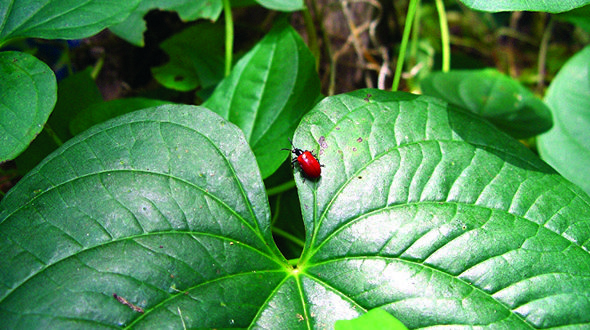
Hernandez.
A dozen Miami-Dade Parks Department and environmental leaders accompanied by four Kendall science students strode into the Indian Hammocks Park woodland preserve on a sunny April morning. Leading the procession was Tim Joyner, a county Environmental Resources project supervisor, a plastic container tucked under his arm holding the first live weapon that thrives on a tree-strangling vine that has spread throughout local forest preserves and elsewhere in the U.S. for over a century.
Wherever the vine or its new seedlings (called bulbils) have taken hold, Joyner and others placed 50 beetles native to China (Lilioceris Cheni) who enjoy munching the elephant-ear shaped leafs of the potato leaf vine.
Since no effective pesticide has been found to eliminate the potato leaf, control is accomplished mostly by work crews who annually circulate in two-week trips to each park preserve, ripping out the weedy vegetation and uprooting bulbil offshoots, just to keep the vine from spreading totally out of control.

Discovering the penchant of the nonthreatening beetle to thrive on its leaves as a solution to eradicate the menace merited a special celebration on Apr. 11, especially for four graduating seniors from Kendall’s Terra Environmental Research Institute High School (TERRA), each playing a significant role in developing research into the project that had begun earlier in Broward County.
As Miami’s first LEED-certified “green” school, TERRA students use neighboring Indian Hammocks Park for research and hands-on land management experiments, conducted under the mentorship of Miami- Dade Parks’ Natural Areas Management Division (NAM) officials.
Due this year to earn the first diplomas from the science-oriented high school that opened four years ago are Maria Rojas, 18, and Veronica Gomez, 18, both of Kendalll; Michelle Castillo, 17, of Cutler Bay, and Tristan Hernandez, 17, of Coconut Grove.
“We’re a different kind of ‘Beetles,’ Rojas laughed at the suggestion the students adopt the legendary musical group name after she described how they spent countless hours measuring leaf growths and beetle appetites.
“That includes 94-degree summer months camping in Indian Hammocks Park to watch over our experiments,” Rojas added, standing near a display of beetle growth cultures and a typical plant under voracious siege by the insect.
Now inspired to continue a scientificrelated career, Rojas’ project contribution: How color distinguishes potato leaf vine growth rates.
Castillo, who studied soil growth effects, is fascinated but undecided about a future in science while Gomez, who correlated soil types for plant reproduction, said, “My interest has really expanded from studying bio-systems. I’m sure some environmental science is in my future.”
Hernandez, who compared the bulbil sizes with vine growth,s has no doubt of his calling.
“I’m planning to major in environmental science,” he said emphatically. “Ever since my dad took me camping and studying for Scout merit badges, scientific research is my first and only objective for the future.”
All four won plaudits from their mentors and supervisors at the park outing that included special words of praise from Dr. Min Rayamajhi of the USDA-ARS Invasive Plant Research Institute; TERRA assistant principal Jennifer Nepper, on behalf of principal Caridad Montano, and parks director Jack Kardys.
The leaf-eating beetles, who now dine on Indian Hammocks Park‘s infestation, have begun the first bio-destruction of the stubborn menace to native tropical foliage — now in 46 of the county’s 80 natural park preserve areas.
If its eating habits prove successful over the next year, the beetle’s unique appetite for that particular leaf could lead to eradication of a kudu-like spread grown uncontrollably throughout the southern U.S. from Florida to southern California.
Native to tropical Asia, the potato leaf vine thrives freely except for manual exterminations over the past 100 years, displacing sufficient native species in Florida to win selection on the state’s Noxious Weed List.
“We’ll be monitoring leaf destruction carefully over the next year to see if these beetles really are the answer to biological control of vine growth,” said Joe Maguire, manager of NAM, who has fought the invasion of the exotic plant growth for 25 years.
Concerned about the tree blanket countywide, Maguire said only 18 percent of Miami-Dade has sufficient coverage instead of an ideal 36 percent.
“This park stands alone in Miami-Dade for its appeal to all kinds of people,” Kardys noted. “Of a total 105 acres, onehalf remains as a natural preserve, and we want to keep it intact.”






